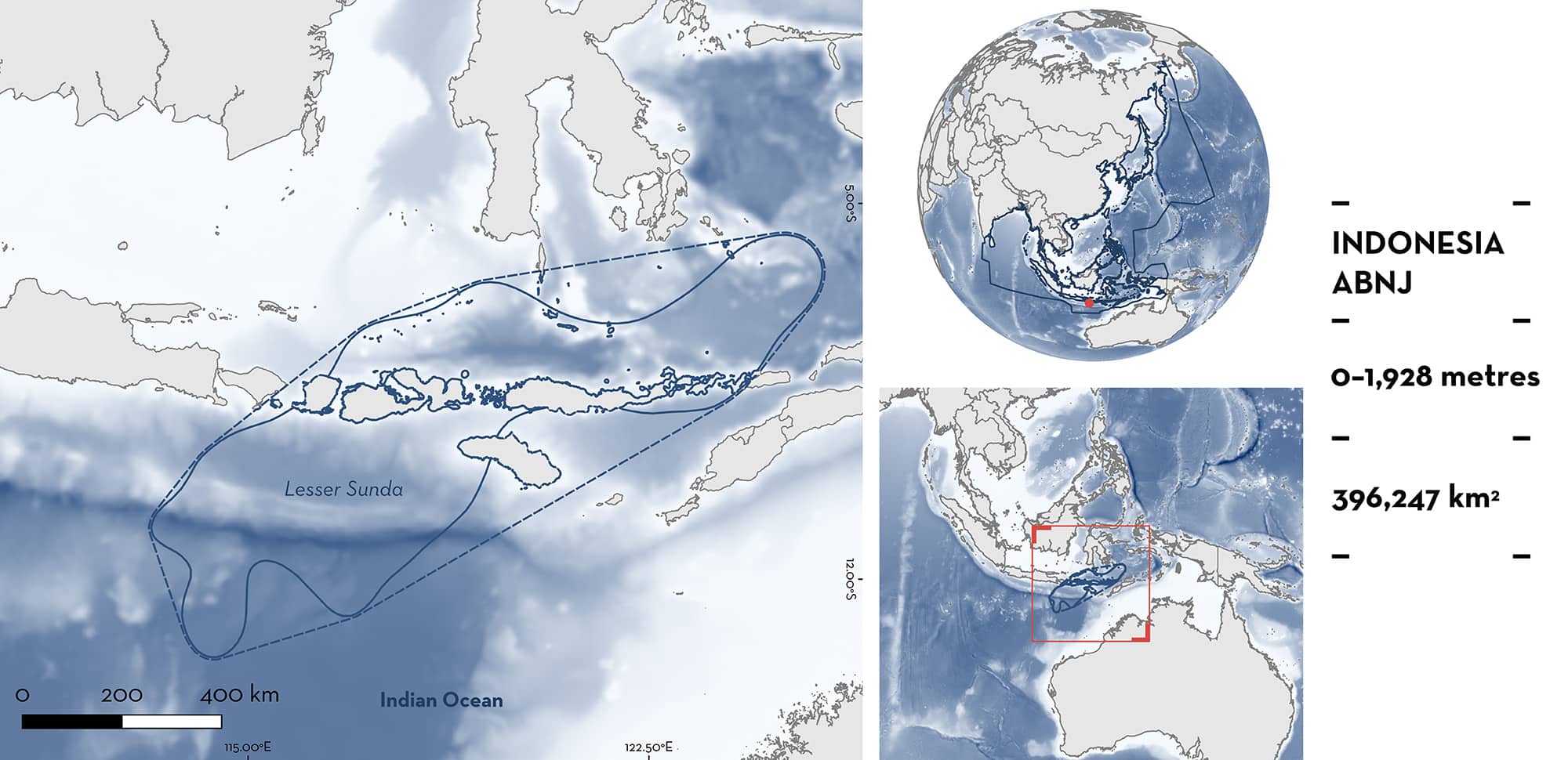ISRA FACTSHEETS
ISRA FACTSHEETS
ASIA REGION
Lesser Sunda
Summary
Lesser Sunda is located in southern Indonesia and spans into areas beyond national jurisdiction (ABNJ). The area includes waters of the Java Sea, Flores Sea, and Savu Sea and is characterised by several small islands and bays. Lesser Sunda is a high-productivity area due to seasonal upwellings produced by monsoon winds. The area overlaps with one Ecologically or Biologically Significant Marine Area, eight Key Biodiversity Areas, and 17 marine protected areas. Within this area there are: threatened species and movement areas (Whale Shark Rhincodon typus).
Download factsheet
Lesser Sunda
DESCRIPTION OF HABITAT
Lesser Sunda is located in southern Indonesia and extends into areas beyond national jurisdiction (ABNJ). The area includes waters of the Java Sea, Flores Sea, and Savu Sea. Lesser Sunda is characterised by several small islands and bays, including Saleh Bay (Sumbawa Island), a high-productivity site due to large inputs from rivers year-round and seasonal upwellings produced by monsoon winds (Herdiana et al. 2023).
The northwest monsoon (December to February) brings low-speed winds and high rainfall while the southeast monsoon (June to August) brings high-speed winds and lower precipitation (Wirasatriya et al. 2021). These winds induce coastal upwelling across the area that cause phytoplankton and zooplankton blooms, especially during the southeast monsoon (Simanjuntak & Lin 2022). In addition, in the southern part of the area, upwellings are produced by the El Nino-Southern Oscillation (Simanjuntak & Lin 2022).
The area overlaps with the South of Java Island Ecologically or Biologically Significant Marine Area (EBSA; CBD 2024). It also overlaps with eight Key Biodiversity Areas (KBA): Kepulauan Selayar, Pantai Mananga Aba – Pantai Waeketo, Perairan Komodo – Rinca, Perairan Lembata, Perairan Wakatobi, Riung 17 Pulau, Teluk Maumere and Selat Pantar (KBA 2024a, 2024b, 2024c, 2024d, 2024e, 2024f, 2024g, 2024h); and with 17 marine protected areas: KKPD Kabupaten Lombok Barat Marine Recreational Park, Taman Wisata Perairan Teluk Bumbang, Taman Wisata Perairan Gili Sulat Dan Gili Lawang, P. Keramat, P. Bedil, P. Temudong, Taman Nasional Perairan Laut Sawu, Taman Wisata Perairan Gili Banta, Komodo National Park, Suaka Alam Perairan Kabupaten Flores Timur, Pulau Lembata, Suaka Alam Perairan Selat Pantar Dan Perairan Sekitarnya, Take Bone Rate, Kepulauan Wakatobi, Pulau Mayo, Pulau Satonda, Tujuh Belas Pulau, Pulau Besar, and Teluk Maumere.
This Important Shark and Ray Area is pelagic and is delineated from inshore and surface waters (0 m) to 1,928 m based on the global depth range of the Qualifying Species.
CRITERION A
VULNERABILITY
One Qualifying Species within the area is considered threatened with extinction according to the IUCN Red List of Threatened Species. The Whale Shark is assessed as Endangered (Pierce & Norman 2016).
CRITERION C
SUB-CRITERION C4 – MOVEMENT AREAS
Lesser Sunda is an important movement area for one shark species.
Between 2016–2023, 23 Whale Sharks measuring between 300–700 cm total length (TL) were tagged in Saleh Bay with satellite transmitters (Sianipar 2022; Konservasi Indonesia unpubl. data 2023). Tagged individuals (n = 14) moved back and forth from coastal aggregation and feeding sites in Saleh Bay and the Nusa Tenggara Islands to areas in the Java Sea, Bali Sea, Flores Sea, and Savu Sea, with incursions into areas beyond national jurisdiction (ABNJ). The offshore areas in the Java Sea and Flores Sea where these individuals moved are poorly monitored as it is logistically very complicated to go to these sites, so no other aggregation sites have been identified there. However, movements in this area included visits to East Flores, Alor, and Wakatob, where Whale Sharks have been observed feeding (Konservasi Indonesia unpubl. data 2023). In addition, offshore areas in the southern Indonesian Exclusive Economic Zone and ABNJ where Whale Sharks moved match the oligotrophic spawning grounds of bluefin tunas and other pelagic species in the southeastern Indian Ocean (Schaefer 2002; Nieblas et al. 2014). Whale Sharks may go there to feed on these year-round spawning aggregations, but the remoteness of this area has not allowed this to be confirmed. There was no seasonality associated with movements to offshore areas. Lesser Sunda was defined according to the locations of Whale Sharks tagged with satellite transmitters. A non-autocorrelated Kernel Density Model was built and the UD = 50% was used as the boundary.
A few individuals moved into the Timor Sea, the Banda Sea, and the Arafura Sea, and to areas within the Australia and Timor-Leste exclusive economic zones, but movements into those areas were not regular nor predictable so were not considered part of the important area (Konservasi Indonesia unpubl. data 2023).
Despite the extension of their movements, there was only an overlap of 4% with the movements of Whale Sharks tagged in western Papua, confirming the presence of distinct corridors for different aggregations.
Download factsheet
SUBMIT A REQUEST
ISRA SPATIAL LAYER REQUEST
To make a request to download the ISRA Layer in either a GIS compatible Shapefile (.shp) or Google Earth compatible Keyhole Markup Language Zipped file (.kmz) please complete the following form. We will review your request and send the download details to you. We will endeavor to send you the requested files as soon as we can. However, please note that this is not an automated process, and before requests are responded to, they undergo internal review and authorization. As such, requests normally take 5–10 working days to process.
Should you have questions about the data or process, please do not hesitate to contact us.


